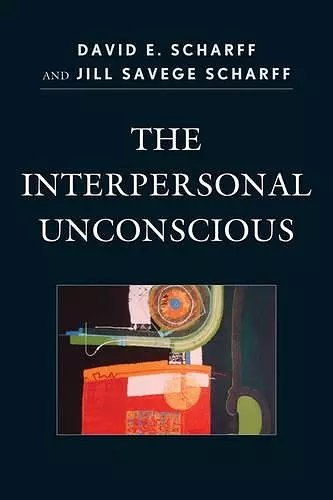The Interpersonal Unconscious
David E Scharff author Jill Savege Scharff author
Format:Hardback
Publisher:Jason Aronson Publishers
Published:13th Oct '11
Currently unavailable, our supplier has not provided us a restock date
This hardback is available in another edition too:
- Paperback£38.00(9780765708717)

In The Interpersonal Unconscious, the Scharffs explore the construction and expression of the unconscious in interpersonal interaction. The authors draw from individual analysis, conjoint psychotherapy with families and couples, and from the use of group process in teaching. They introduce chaos theory applied to dynamical systems and South American theories of the link and the analytic field, now available in English. Advances in development, neuroscience, ethology, and attachment theory all contribute to their expanded view of the unconscious mind and its relationships. In turn, the Scharffs' view of the interpersonal unconscious revises current views of development, clinical theory, and unconscious psychic organization. The unconscious is not individual as Freud thought: It is fundamentally interpersonal at the same time that it feels intensely our own. We live in an unconscious field. Each of us contributes to it, and each is structured and enriched by it. We are social creatures, not only in our behaviors and interactions, but in the deepest recesses of our minds. We can no longer conceive of the unconscious as an individual property according to Freud's original topographic and structural theories. Even though the individual unconscious is unique, paradoxically it is also shared in reciprocal interactions with intimate partners, work groups, and social groups. In this state of mutual influence, our unconscious minds are constantly under construction across the life cycle.
The new volume by David and Jill Scharff represents further development and an integration of their earlier contributions to psychoanalytic object relations theory, and the integration of psychoanalytic theory with new developments in adjacent scientific fields. Here, they present a broad panorama of the relationship of object relations theory, link theory and field theory, chaos theory, and up to date relevant findings in neurobiological and attachment research. They apply this complex original framework to contemporary clinical psychoanalytic approaches to individual treatment, couples therapy, and family therapy in a rich, clearly formulated illustration of the clinical relevance of this theoretical approach. It is an exciting exploration of the present expansion and challenges of theoretical and clinical psychoanalysis; thought provoking and practical at the same time. -- Otto F. Kernberg, MD, New York Presbyterian Hospital, Cornell University, and Columbia University Center for Psychoanalytic Training and Research
From a European perspective, this wonderful book creates a bridge between subject and object, between internal and external reality, and between North American and European psychoanalysis. Through the authors’ deep, experiential knowledge of the international psychoanalytic field, it shows how contemporary psychoanalysts can harmoniously integrate different theories and techniques. -- Stefano Bolognini, MD, President of the Italian Psychoanalytic Society, President-Elect of the International Psychoanalytic Association
The great strength of the book is the coherence of the unfolding narrative of ideas that provide a framework for working with couples and families. The Scharffs, as they are often collectively referred to, have stayed true to their object relations foundations and maintain these as they explore influences from other disciplines and different parts of the world. They offer us a window into the journey they have made, and continue to make, as thinking clinicians, and by doing so, invite and sometimes challenge us to reflect on our own assumptions and methods. * The Journal of Couple and Family Psychoanalysis *
ISBN: 9780765708694
Dimensions: 240mm x 162mm x 21mm
Weight: 494g
220 pages